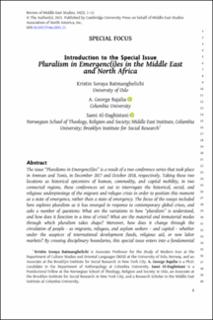| dc.description.abstract | The issue “Pluralisms in Emergenc(i)es” is a result of a two-conference series that took place in Amman and Tunis, in December 2017 and October 2018, respectively. Taking these two locations as historical epicenters of human, commodity, and capital mobility, in two connected regions, these conferences set out to interrogate the historical, social, and religious underpinnings of the migrant and refugee crisis in order to position this moment as a state of emergence, rather than a state of emergency. The focus of the essays included here explores pluralism as it has emerged in response to contemporary global crises, and asks a number of questions: What are the variations in how “pluralism” is understood, and how does it function in a time of crisis? What are the material and immaterial modes through which pluralism takes shape? Moreover, how does it change through the circulation of people - as migrants, refugees, and asylum seekers – and capital – whether under the auspices of international development funds, religious aid, or new labor markets? By crossing disciplinary boundaries, this special issue enters into a fundamental discussion about how “pluralism” is conceived across sites and offers new vistas for its conceptualization in North Africa and the Middle East. | en_US |

